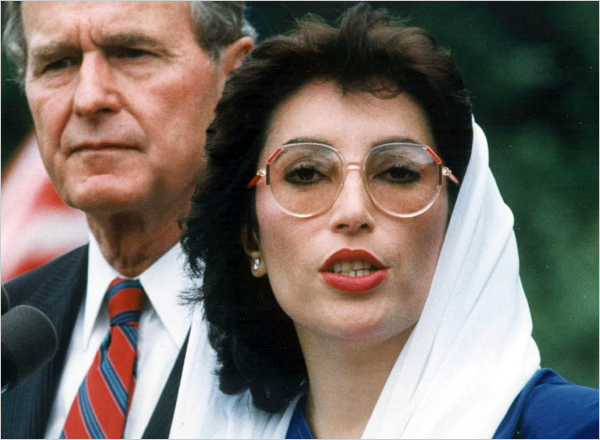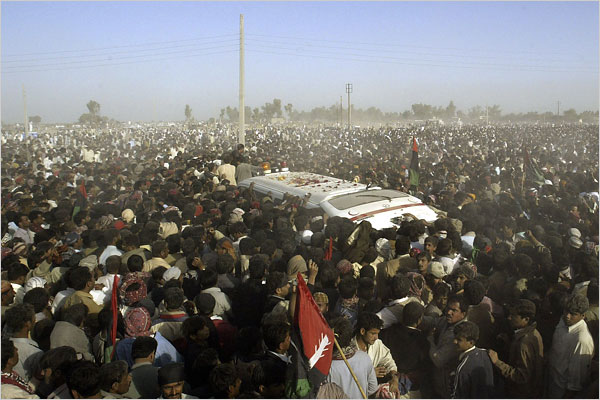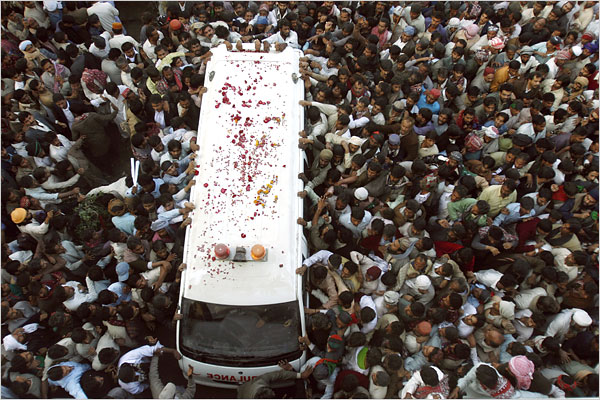| Want to send this page or a link to a friend? Click on mail at the top of this window. |
| More Books and Arts |
| Posted December 30, 2007 |
| CONNECTIONS |
| How Bhutto Won Washington |
 |
|
GREG GIBSON/AGENCE FRANCE-PRESSE - GETTY IMAGES |
|
| TAPPED IN Prime Minister Benazir Bhutto with the first President Bush at the White House in 1989. |
By ELISABETH BUMILLER |
| WASHINGTON |
BENAZIR BHUTTO always understood Washington more than Washington understood her.
Ms. Bhutto, the Pakistani opposition leader and two-time prime minister, who was assassinated in Rawalpindi on Thursday as she campaigned for the office a third time, had a more extensive network of powerful friends in the capital’s political and media elite than almost any other foreign leader. Over the years, she scrupulously cultivated those friends, many from her days at Harvard and Oxford. She was rewarded when her connections — at the White House, in Congress and within the foreign policy establishment — helped propel her into power in Pakistan.
But in the end, with yet another American administration behind her, Ms. Bhutto’s Washington network only underscored how little the United States fathomed the feudal politics of South Asia, and its own ability to control events in the cauldron of Pakistan.
“I always thought this was roughly how it would end for her, but I didn’t think it would happen today,” Peter W. Galbraith, a former United States ambassador and a longtime friend of Ms. Bhutto’s, said in an interview on Thursday.
 |
ZAHID HUSSEIN/REUTERS |
| Hundreds of thousands of emotional mourners bade farewell Friday to Benazir Bhutto in Garhi Khuda Baksh, Pakistan. An ambulance carrying Ms. Bhutto's remains crawled slowly through the dusty afternoon haze. |
A descendant of a feudal landholding family in Sindh, a southern province, Ms. Bhutto was raised in a mansion in the Karachi seaside neighborhood of Clifton and educated at Christian convent schools. She arrived at Harvard in the fall of 1969 as a primly dressed 16-year-old, bewildered by American customs. “I was amazed at how people talked to their parents — not enough respect,” she later told The Washington Post.
But Ms. Bhutto adapted, and quickly befriended not only Mr. Galbraith but E. J. Dionne and Michael Kinsley, now both columnists for The Post, and Walter Isaacson, the president of the Aspen Institute and a former managing editor of Time. By the time she got to Oxford, Ms. Bhutto drove a sports car, and she soon became president of the Oxford Union debating society. “I remember her being very intense,” Mr. Isaacson recalled. “But she had this really big smile, and she had this ability to be charming.”
Ms. Bhutto’s first important trip to Washington was in the spring of 1984, when Mr. Galbraith, then a Democratic staff member on the Senate Foreign Relations Committee, acted as her host and tutor. By then she was 30 years old and scarred from the bloody politics back home. Her father, Zulfikar Ali Bhutto, had been president and prime minister of Pakistan but was hanged in 1979 on the orders of Gen. Mohammad Zia ul-Haq, Pakistan’s military ruler. Ms. Bhutto, who had spent months in prison and years under house arrest, was now leader of the Pakistan Peoples Party of her father and determined to oust General Zia.
 |
SHAKIL ADIL/ASSOCIATED PRESS |
| The funeral in Ms. Bhutto's ancestral village was chaotic but peaceful. |
Her goal in Washington was to persuade conservative Reagan administration officials that they would be better off with her in power. It was not going to be easy: Ms. Bhutto’s father was known for his fiery anti-Western rhetoric, and she had marched against the Vietnam War at Harvard.
“What she was up against was her reputation of being this anti-American radical,” Mr. Galbraith said. “So we spent a lot of time talking about what messages she needed to convey.”
In meetings with key members of Congress at the time — among them Senator Charles H. Percy, the Illinois Republican who was chairman of the Foreign Relations Committee, and Representative Stephen J. Solarz of Brooklyn, who was a senior Democrat on the House Foreign Affairs Committee — Ms. Bhutto, under Mr. Galbraith’s tutelage, expressed her support for democracy and the mujahedeen “freedom fighters” who were battling the Soviet invasion in Afghanistan.
“She was this completely charming, beautiful woman who could flatter the senators, and who could read their political concerns, who could persuade them that she would much better serve American interests in Afghanistan than Zia,” Mr. Galbraith said.
On that same trip, Mr. Galbraith introduced Ms. Bhutto to Mark Siegel, a political operative who had been executive director of the Democratic National Committee. Mr. Siegel was taken with Ms. Bhutto and supported her cause. He became a lobbyist for the government of Pakistan when Ms. Bhutto was in power. Most recently he was her collaborator on a book scheduled for publication in 2008.
“I started to walk the halls of Congress with her in 1984, and she developed poise and confidence and maturity,” Mr. Siegel said. “She also understood how important these relationships were.” Still, he said, “I would have dinner parties at my house in the beginning, and it was not so easy to get journalists and congressmen and senators to come.”
That changed in November 1988, when Ms. Bhutto’s party won a plurality in Parliament in the Pakistani elections but fell short of a majority. As Mr. Galbraith tells it, Reagan administration officials went to Ghulam Ishaq Khan, Pakistan’s acting president, and told him that since Ms. Bhutto commanded the most votes, he would have to invite her to form a government. Ms. Bhutto became prime minister on Dec. 2.
“And that was the direct result of her networking, of her being able to persuade the Washington establishment, the foreign policy community, the press, the think tanks, that she was a democrat, that she was a moderate, that she was going to be against the Soviets in Afghanistan,” Mr. Galbraith said.
Husain Haqqani, a former adviser to Ms. Bhutto and a professor of international relations at Boston University, agreed that her Washington network helped her become prime minister, particularly in the face of Pakistan’s powerful army and intelligence service. “Had the Americans not put their foot down, the military-intelligence services would have stopped her,” Mr. Haqqani said.
Although Ms. Bhutto was twice expelled from office on charges of corruption, she kept up her visits to Washington, usually several a year. She would call on administration officials and members of Congress willing to see her as well as reporters and editors at The New York Times, The Washington Post and The Wall Street Journal. Soon her American Christmas card list, excluding people in government and Congress, was up to 375 names.
“She understood the nature of political life, which is to stay in touch with people whether you’re in or out of office,” said Karl F. Inderfurth, the former assistant secretary of state for South Asia who attended a dinner for Ms. Bhutto at the Willard Hotel on her last trip to Washington, in September. “She was a superb political operative.”
Like other foreign leaders, Ms. Bhutto engaged a public relations firm to arrange meetings for her with administration officials, members of Congress and journalists. For the first six months of 2007, the firm Burson-Marsteller took in fees of close to $250,000 for work on behalf of Ms. Bhutto.
Ms. Bhutto kept up her networking until the very end. Last week, Mr. Siegel said, he e-mailed Ms. Bhutto to tell her he had heard that their publisher, HarperCollins, was pleased with the book the two had just turned in, “Reconciliation: Islam, Democracy and the West.” He received a happy response from Ms. Bhutto by BlackBerry. “Which we called her ‘crackberry’ because she was so addicted to it,” Mr. Siegel said.
The time was 2 a.m. Thursday, noon in Rawalpindi. Six hours later, Ms. Bhutto was dead.
As always, her last e-mail message to Mr. Siegel had been an almost instantaneous response. “She would answer me within 15 minutes, even at crazy times,” Mr. Siegel said. “I said, ‘Why are you up?’ And she would say, ‘I’m working.’ ”
Kitty Bennett contributed reporting.
Copyright 2007 The New York Times Company. Reprinted from The New York Times, Week in Review, of Sunday, December 30, 2007.
RELATED TEXT: A look at the Bhutto family dynasty
| Wehaitians.com, the scholarly journal of democracy and human rights |
| More from wehaitians.com |